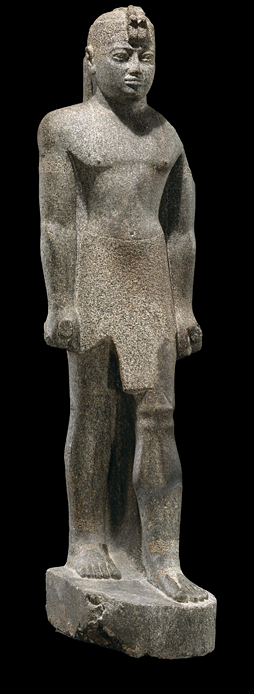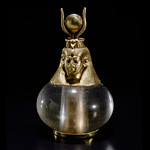
Statue of King Senkamanisken
Granite gneiss, Gebel Barkal, 640–620 bc (Napatan Period, reign of Senkamanisken).
Harvard University—Boston Museum of Fine Arts Expedition: 23.731
Photography © 2011 Museum of Fine Arts, Boston
As branches of the Nile River descend from the highlands of East Africa, they join in a single course and pass through the land of Nubia, in what is now northern Sudan and southern Egypt. The river has always provided life in this arid region as a source of water, food, and transport. It flows through areas known as cataracts, traditionally numbered from north to south, where the river valley narrows and rocky outcrops define islands, rapids, and waterfalls. The Nile also traverses broad plains that provide a basis for agriculture as well as for concentrations of population, wealth, and power. The savannas and deserts on either side of the river are integral to settlement, supplying raw materials including gold as well as areas for herding and hunting.
The population of the Nile Valley increased with the first permanent settlements, beginning around 8000 BC. In about 5000 BC, as the climate became drier and the Sahara Desert expanded, people domesticated sheep, goats, and cattle and later cultivated wheat, barley, dates, millet, and sorghum. While there were signs of social inequality in these earlier periods, it was not until just before 3000 BC that long-distance trade, increasingly sophisticated craft production, and the accumulation of wealth and power marked the rise of the first kingdoms of the Middle Nile.
Located on the main transportation route in north-eastern Africa, Nubia cannot be understood in isolation from its neighbors, particularly Egypt to the north. Although Egypt and Nubia were trade partners and Nubians served in the Egyptian army, the two lands were also adversaries, and Egyptian ideology made Nubia one of its traditional enemies. Egyptian texts used the standard phrase “vile Kush” to refer to the most powerful early Nubian kingdom, and Egyptian visual representations often stereotyped Nubians so they appeared primitive and uncivilized. At the same time, Nubians selectively adopted and modified aspects of Egyptian culture.
This exhibition presents an opportunity to understand Nubia on its own terms. It evokes the rise, fall, and re-emergence of Nubian power over 2,500 years, from the earliest Nubian kingdoms through the Napatan Dynasty’s conquest of Egypt beginning in about 750 BC. It presents developments in art and crafts, warfare and ideology, wealth and trade as means of understanding this relatively poorly known ancient civilization.
The first gallery displays early ceramics that illustrate techniques distinctive to Nubian traditions, including burnishing, blackening, geometric decoration, and imitation of natural forms. Production of faience—a greenish glazed material whose manufacture was introduced from Egypt—illustrates the ways that art can be affected by political history.
The second gallery, derived mostly from later phases of Nubian history, presents aspects of Nubia’s relationship with Egypt, as well as the distinctive synthesis of indigenous and Egyptian features in the Napatan period.

